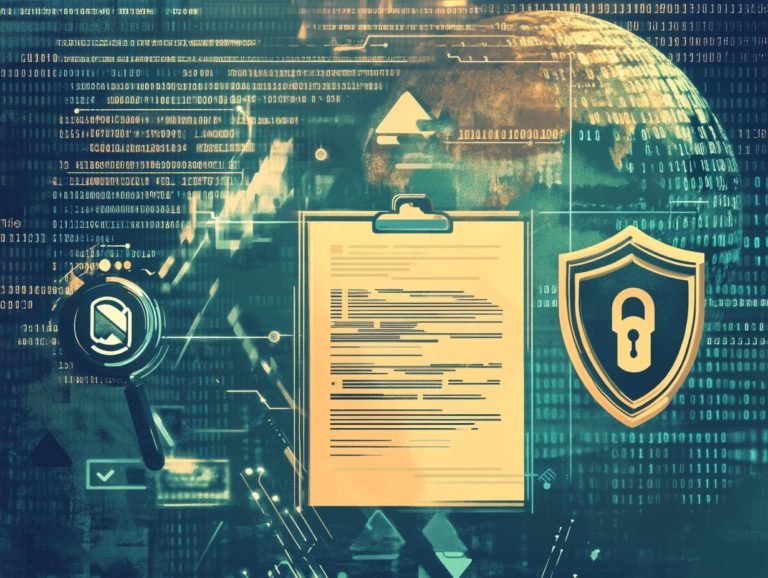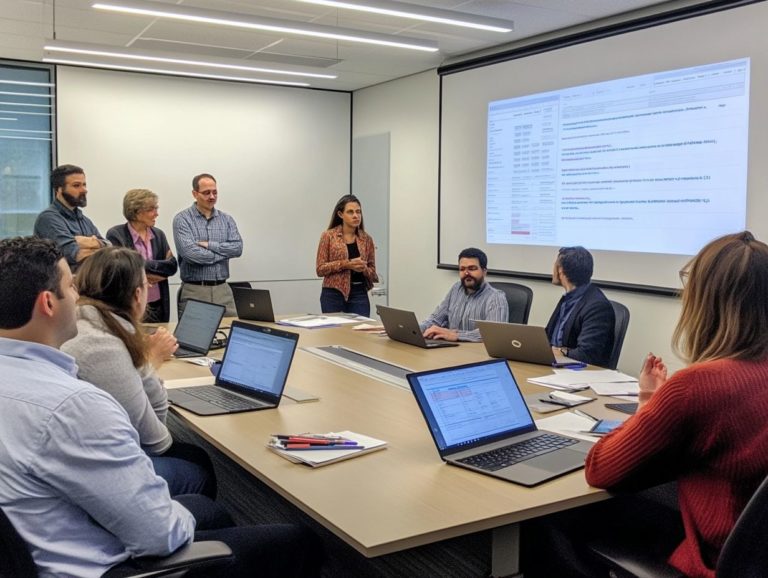cybersecurity audits: what to expect
In today s digital landscape, cybersecurity audits are essential for any organization aiming to safeguard sensitive information. This guide helps you understand what audits involve and why they matter.
You ll explore the steps to prepare for an audit and what to expect during the process. This guide also covers best practices for maintaining strong cybersecurity long after the audit.
Engage with this content to keep your organization secure and compliant.
Contents
Key Takeaways:

- Cybersecurity audits help identify vulnerabilities and ensure compliance with regulations.
- Prepare for a cybersecurity audit to minimize potential findings.
- Carefully interpret audit results to implement improvements for ongoing security.
Understanding Cybersecurity Audits
Understanding cybersecurity audits is crucial for strengthening your security. These audits evaluate your organization’s security measures against evolving threats.
A cybersecurity audit assesses your internal controls, compliance rules, and incident response plan. It helps you identify potential risks and implement effective controls.
This proactive approach protects sensitive data and reduces the chances of data breaches.
What is a Cybersecurity Audit?
A cybersecurity audit is a detailed evaluation of your organization’s information systems and security processes. It’s aimed at ensuring compliance with regulations and best practices.
This process includes assessing risks and evaluating safeguards. You ll identify areas needing improvement to bolster security.
Using methods like vulnerability scanning uncovers weaknesses, while penetration testing simulates cyber attacks to test your defenses.
Regular audits ensure compliance and promote continuous improvement in data security. Stay ahead of threats and protect sensitive information.
Reasons for Conducting Cybersecurity Audits
Cybersecurity audits help you identify vulnerabilities in your security. This approach strengthens your defenses against cyber threats and ensures compliance with regulations.
Identifying Vulnerabilities and Weaknesses
To identify vulnerabilities during an audit, conduct a vulnerability scan. This scan reveals potential risks within your organization s systems.
Automated tools assess networks and applications, highlighting security gaps. Don’t forget that manual assessments by experts can uncover deeper issues.
Combining insights from both methods helps refine your cybersecurity strategy. This ensures your resources effectively protect your digital assets.
Compliance with Regulations and Standards

Compliance with regulations and standards is crucial for cybersecurity audits. It helps you meet your legal obligations for data protection.
This compliance becomes even more vital with stringent regulations like the Payment Card Industry Data Security Standard (PCI DSS) and the General Data Protection Regulation (GDPR), which carry hefty penalties for non-compliance.
Conduct thorough audits to catch potential vulnerabilities early. This helps you avoid serious problems down the line. Regular audits not only help maintain compliant data security practices but also cultivate a culture of accountability and awareness among your employees.
This proactive approach boosts your organization’s security and builds trust with customers and regulators.
Preparing for a Cybersecurity Audit
Preparing for a cybersecurity audit requires you to undertake a series of essential steps. These steps are vital for ensuring that your security measures and incident response plans are robust and effective against potential threats.
Steps to Take Before the Audit
Before embarking on a cybersecurity audit, it’s imperative for organizations to take key preparatory steps. Conduct employee training, review security policies, and ensure your incident response plan is current.
This groundwork minimizes vulnerabilities by equipping your staff with the knowledge needed to recognize potential threats.
Regular training sessions are essential! They empower your team to spot phishing attempts and implement strong password practices.
A comprehensive review of existing security policies enables you to identify gaps and ensure compliance with legal requirements.
Assess your incident response plan. This ensures that all team members know their roles during a security breach, fostering a coordinated response to incidents.
By prioritizing these elements, you significantly enhance your organization s overall security posture.
What to Expect During a Cybersecurity Audit
During a cybersecurity audit, you can anticipate an in-depth evaluation of your security controls. This process encompasses various assessments, including vulnerability scanning and penetration testing, all designed to pinpoint potential weaknesses in your defenses.
Types of Assessments and Tests
You ll encounter various assessments and tests during a cybersecurity audit, such as vulnerability scanning and penetration testing, each tailored to uncover specific security flaws.
Vulnerability scanning is an automated process that meticulously examines your network or application configurations. It identifies known weaknesses and misconfigurations. This proactive approach enables you to spot gaps in your defenses before they become enticing targets for malicious actors.
Penetration testing simulates real-world attacks to exploit those identified vulnerabilities. This hands-on method reveals potential entry points for cybercriminals and measures the effectiveness of your current security measures.
Together, these assessments provide a comprehensive understanding of your security landscape, enabling you to prioritize necessary fixes and fortify your defenses against evolving threats.
Areas of Focus and Evaluation Criteria

Focus on assessing your security controls, legal requirements, and overall risk management strategies within your organization.
This process emphasizes critical components such as network security. Examine vulnerabilities in firewalls, intrusion detection systems, and encryption methods.
Scrutinize cloud security to ensure that data stored in cloud services follows best practices for data protection and compliance.
Review your access controls, which dictate who can access sensitive information and how these permissions are managed. This ensures that only authorized personnel can reach critical systems.
By thoroughly evaluating these areas, you can identify potential weaknesses and implement robust measures to effectively mitigate risks.
Interpreting and Responding to Audit Results
Interpreting and responding to audit results is a crucial step in the cybersecurity audit process. By doing so, you enable your organization to tackle identified issues effectively and implement essential enhancements to your security measures.
This proactive approach not only strengthens your defenses but also fosters a culture of continuous improvement in safeguarding your digital assets.
Addressing Identified Issues and Implementing Improvements
Addressing the identified issues and implementing the necessary improvements following a cybersecurity audit is vital for enhancing your organization s security posture and mitigating potential risks.
By adopting a complete approach, you can focus on refining your security policies and establishing a robust framework to protect sensitive data.
Increasing employee training programs is essential. This ensures that your staff is well-versed in the latest threat landscapes and equipped to recognize suspicious activities.
Updating your security measures may include adopting advanced encryption tools. Multi-factor authentication adds another layer of protection against unauthorized access.
Regularly reviewing these strategies strengthens your defense mechanisms and cultivates security awareness throughout the workforce. Ultimately, this leads to a more resilient organization in the face of cyber threats.
Maintaining Cybersecurity Post-Audit
Maintaining cybersecurity after an audit is crucial for any organization. It ensures that your security measures are not only active but also strong and integrated into a comprehensive cybersecurity program.
Continuous monitoring is key to defending against the ever-changing landscape of cyber threats. This proactive approach also cultivates security awareness throughout the organization.
Best Practices for Ongoing Security Measures
Implementing best practices for ongoing security measures is essential for maintaining a robust cybersecurity program. It ensures that you and your colleagues are well-versed in security policies.
To achieve this, prioritize regular training sessions that keep everyone informed about the latest threats and security protocols. Consistently performing thorough security checks allows you to identify potential weaknesses before they become liabilities.
Updating security policies is equally important. This ensures they remain relevant and effective in an ever-evolving digital landscape.
By fostering a culture of security awareness and seamlessly integrating these practices into your daily workflow, you can significantly reduce the risk of breaches and bolster your overall defense mechanisms.
Frequently Asked Questions

What is a cybersecurity audit?
A cybersecurity audit is a thorough examination of an organization’s information systems, policies, and procedures to identify potential vulnerabilities and areas for improvement.
Why should a company conduct a cybersecurity audit?
A company should conduct a cybersecurity audit to assess the effectiveness of its security measures, identify potential risks, and ensure compliance with industry regulations and standards.
Who typically conducts a cybersecurity audit?
A cybersecurity audit is usually conducted by an independent third-party auditor, such as a certified information systems auditor (CISA), to ensure objectivity and impartiality.
What can I expect during a cybersecurity audit?
During a cybersecurity audit, you can expect the auditor to review your organization’s security policies and procedures. They will conduct vulnerability assessments and interview key personnel to gather information about your security practices. To ensure a smooth process, it’s helpful to know how you can prepare for a cybersecurity audit.
What are some common areas that are evaluated during a cybersecurity audit?
Some common areas evaluated during a cybersecurity audit include network security, access controls, data protection measures, disaster recovery plans, and employee training programs.
What should I do after a cybersecurity audit?
After a cybersecurity audit, you must quickly review the auditor’s findings and recommendations. Take necessary steps to address any identified vulnerabilities or gaps in your security measures. Regularly conducting cybersecurity audits can help improve your overall security posture and protect your organization from cyber threats.






